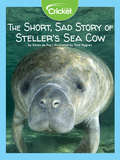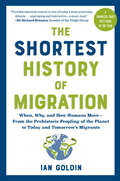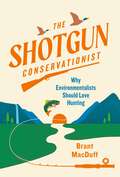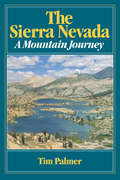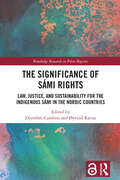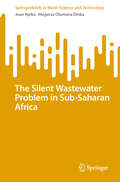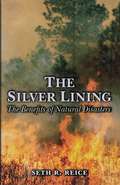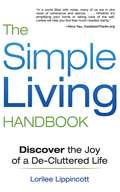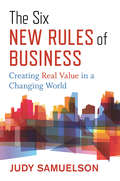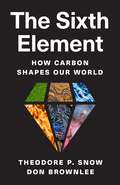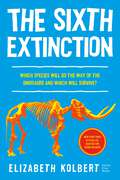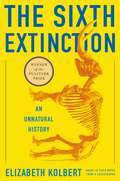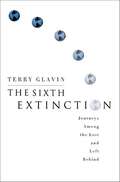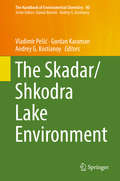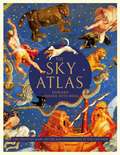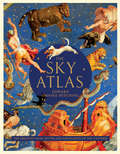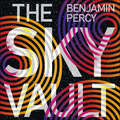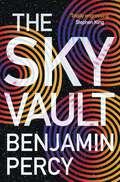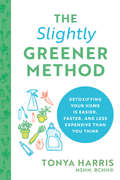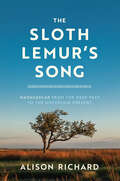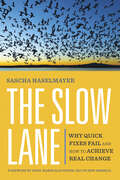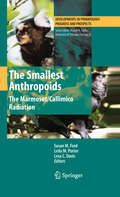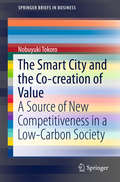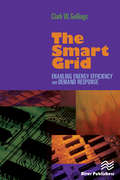- Table View
- List View
The Short, Sad Story of Steller's Sea Cow
by Karen De FoyThe Steller's sea cow, a cousin to the manatee, was hunted to extinction just 27 years after it was discovered. Another century passed before humans realized the need to preserve endangered species. Today scientists are working to ensure its cousin, the Florida manatee, doesn’t meet the same fate.
The Shortest History of Migration: When, Why, and How Humans Move - From the Prehistoric Peopling of the Planet to Today and Tomorrow's Migrants (The Shortest History Series)
by Ian GoldinFrom the Silk Roads to the Berlin Wall, discover the globe-turning history of human migration. “Provides essential context to one of today’s most polarizing debates . . . engrossing and instructive—a must-read.”—Sir Richard Branson, founder of the Virgin Group We are a species in motion—from the first steps of Homo sapiens across Africa to America’s “melting pot.” And when we move—in search of better things, or against our will—our beliefs and skills clash and combine, reshaping society time and again. In this visionary Shortest History of Migration, Ian Goldin uncovers key moments of cultural exchange while carefully examining empire, slavery, and war. Throughout, we meet famous explorers (Zheng He), exiles (Pablo Neruda), and everyday people in extraordinary circumstances: a Jewish man saved by the Kindertransport, a Japanese gardener who blossomed in Mexico City. Today, freedom of movement is being curtailed, even as climate change and conflict mobilize people everywhere around the world. Goldin reminds us that passports at every border are a modern invention (he traces the “birth of big brother” to World War I), revealing the folly of trying to halt migration—and proposing commonsense policy instead. A gripping chronicle of want and wanderlust, this is a moving portrait of humanity—in every sense of the word. The Shortest History books deliver thousands of years of history in one riveting, fast-paced read.
The Shotgun Conservationist: Why Environmentalists Should Love Hunting
by Brant MacDuffAt the intersection of hunting and conservation, a man shares his personal journey from staunch anti-hunter to compassionate, ethical hunter, weaving together a larger history of humans, animals, the environment, and our food systems.The Shotgun Conservationist doesn&’t teach us how to hunt, it explores why we should hunt. As public lands remain imperiled, factory farms pollute the earth and subject animals to inhumane conditions, and global uncertainty presses us all to be more self-sufficient, there has never been a better time to take up hunting. Writer, natural historian, and public speaker Brant MacDuff has done just that. An avid animal lover and raised as a non-hunter, MacDuff started his journey intending to investigate the claim that &“hunting is conservation.&” So convinced, he now holds a hunting license in four states and gives lectures on the positive impact it has on conservation efforts nationwide. Armed with years of experience in the field and a deep love for the natural world, MacDuff tells the provocative, humorous, and insightful story of how he became a hunter. Along the way, readers meet a cast of colorful characters and learn the firsthand research that helped change Brant&’s mind. You may not book a hunting trip after reading The Shotgun Conservationist, but you&’ll have a new perspective on and appreciation for those that do.
The Sierra Nevada: A Mountain Journey
by Tim PalmerThis book presents a natural history of the Sierra Nevada that brings the land, the people, and the surrounding communities to life.
The Significance of Sámi Rights: Law, Justice, and Sustainability for the Indigenous Sámi in the Nordic Countries (Routledge Research in Polar Regions)
by Dorothée Cambou Øyvind RavnaThis book examines the significance of the rights of the Sámi people and analyses the issues raised by the recognition and implementation of these rights in the Nordic countries. Written together by Sámi and non-Sámi experts, the book adopts a human rights approach to examine the adequacy of law and policies that seek to protect the culture and livelihood of Sámi communities in their traditional lands and territories. The book discusses contemporary legal and jurisprudential developments in the field of Sámi rights. It examines the processes and challenges in the recognition and implementation of these rights, particularly in relation to the governance of their traditional land and resources. The book will be of particular interest to legal scholars, political scientists, experts in the field of Indigenous peoples’ rights, governmental authorities, and members of Indigenous communities. The Open Access version of this book, available at www.taylorfrancis.com, has been made available under a Creative Commons (CC-BY) 4.0 license.
The Silent Wastewater Problem in Sub-Saharan Africa (SpringerBriefs in Water Science and Technology)
by Joan Nyika Megersa Olumana DinkaThis book seeks to explore the critical but very influential challenge of wastewater management from a global perspective and to specifics in SSA region where the subject is under researched. The book will detail on the production trends, the treatment approaches used currently and those proposed in a circular economy among other management approaches that can enhance sustainable wastewater management while prioritizing reuse and recovery of the resource. The book is a need of the hour since only a few studies have addressed the production trends and management of wastewater in SSA region as Onu et al. (2023) noted. The aim is to close the research gap and infuse theory from successful case studies of other regions of the world into practice in SSA. Ultimately, with sustainable wastewater management, access to safe water and sanitation can be enhanced in line with realization of sustainable development goal (SDG) 6. The book will be useful to environmental pollution regulators, researchers, and practitioners among other stakeholders with a role in wastewater treatment and management.
The Silver Lining: The Benefits of Natural Disasters
by Seth R. ReiceFloods, fires, volcanic eruptions, earthquakes, hurricanes--we are quick to call them ''natural disasters.'' But are they? Did the great fires that swept Yellowstone in 1988 devastate the park, or did they just ravage our image of the park as a fixed, unchanging national treasure? This lucid, lively book reveals the shortsightedness behind conceiving of such events as disastrous to nature. Indeed, Seth Reice contends, such thinking has led to policies that have done the environment more harm than good--the U.S. Forest Service's campaign against natural forest fires and the Army Corps of Engineers' flood prevention program are examples. He points out ways in which we can better address the wide range of environmental problems humanity faces at the dawn of the new millennium. Reice argues, in terms refreshingly nontechnical yet scientifically sound, that the traditional, equilibrium paradigm--according to which ''stability'' produces healthier ecosystems than does sudden, sweeping change--is fundamentally flawed. He describes a radically different model of how nature operates, one that many ecologists and population biologists have come to understand in recent years: a concept founded on the premise that disturbances help create and maintain the biodiversity that benefits both the ecosystem and ourselves. Reice demonstrates that ecosystems need disturbances to accomplish indispensable tasks such as the production of clean air and water. He recommends changes in environmental management to incorporate the essential role of natural disturbances. This book shows that every tornado's funnel cloud, every forest fire's billowing cloud of smoke, has tremendous benefits for the ecosystem it impacts. As anyone concerned with man's impact on the environment will appreciate, this is the cloud's real silver lining.
The Simple Living Handbook: Discover the Joy of a De-Cluttered Life
by Lorilee LippincottWhere did all this stuff come from? I don’t have time for a life. I need to get away! Ever feel this way? Society is quick to fill our minds and homes with all the latest gadgets, tools, obligations, and entertainment, but what happens when it all doesn’t fit? The Simple Living Handbook is a how-to memoir about creating a life that has space for what really matters to you.Lippincott’s road to simplicity started in the fall of 2010 when she was on the verge of a breakdown. Her life was basically “normal”—husband, two kids, comfortable home, three home businesses—but she felt like she was running a rat race. She was desperate for more time and space to focus on family, health, and her own interests. So she and her husband decided to cut back on clutter—drastically. Now the family of four lives in a one-bedroom apartment with only the possessions they actually need and use; they stick to a simple diet of only whole foods “that God would recognize”; and they have managed to become productive without feeling busy. They’ve never been happier or healthier.Through personal stories, advice, and tips, Lippincott teaches how to make the hard decisions necessary to simplify your home and your schedule. Beyond that, she addresses the hidden emotional hoarding that threatens to keep our souls running in circles. Through her inspiring story, readers will learn to take a step back, reassess priorities, and commit to making space for those people and things that really matter.
The Six New Rules of Business: Creating Real Value in a Changing World
by Judy SamuelsonThe rules of business are changing dramatically. The Aspen Institute's Judy Samuelson describes the profound shifts in attitudes and mindsets that are redefining our notions of what constitutes business success.Dynamic forces are conspiring to clarify the new rules of real value creation—and to put the old rules to rest. Internet-powered transparency, more powerful worker voice, the decline in importance of capital, and the complexity of global supply chains in the face of planetary limits all define the new landscape. As executive director of the Aspen Institute Business and Society Program, Judy Samuelson has a unique vantage point from which to engage business decision makers and identify the forces that are moving the needle in both boardrooms and business classrooms. Samuelson lays out how hard-to-measure intangibles like reputation, trust, and loyalty are imposing new ways to assess risk and opportunity in investment and asset management. She argues that "maximizing shareholder value" has never been the sole objective of effective businesses while observing that shareholder theory and the practices that keep it in place continue to lose power in both business and the public square. In our globalized era, she demonstrates how expectations of corporations are set far beyond the company gates—and why employees are both the best allies of the business and the new accountability mechanism, more so than consumers or investors. Samuelson's new rules offer a powerful guide to how businesses are changing today—and what is needed to succeed in tomorrow's economic and social landscape.
The Sixth Element: How Carbon Shapes Our World
by Theodore P. Snow Don BrownleeA cosmic perspective on carbon—its importance in the universe and our livesWhen we think of carbon, we might first think of a simple element near the top of the periodic table: symbol C, atomic number 6. Alternatively, we might think of something more tangible—a sooty piece of coal or a sparkling diamond, both made of carbon. Or, as Earth&’s temperature continues to rise alarmingly, we might think of the role carbon plays in climate change. Yet carbon&’s story begins long ago, far from earthly concerns. In The Sixth Element, astronomers Theodore Snow and Don Brownlee tell the story of carbon from a cosmic perspective—how it was born in the fiery furnaces of stars, what special chemical and physical properties it has, and how it forms the chemical backbone of the planets and all life as we know it. Foundational to every part of our lives, from our bodies to the food, tools, and atmosphere that sustain our existence, carbon is arguably humankind&’s most important element.Snow and Brownlee offer readers the ideal introduction to the starry element that made our world possible and shapes our lives. They first discuss carbon&’s origin, discovery, and unique ability to bond with other elements and form countless molecules. Next, they reveal carbon&’s essential role in the chemical evolution of the universe and the formation and evolution of galaxies, stars, planets, and life, and then, more generally, its technological uses and its influence on Earth&’s climate. Bringing readers on a historical, scientific, and cross-disciplinary journey, The Sixth Element illuminates the cosmic wonder that is carbon.
The Sixth Extinction (young readers adaptation): An Unnatural History
by Elizabeth KolbertIn this young readers adaptation of the New York Times-bestselling, Pulitzer Prize-winning The Sixth Extinction, Elizabeth Kolbert tells us why and how human beings have altered life on the planet in a way no species has before. Over the last half-billion years, there have been five mass extinctions, when the diversity of life on earth suddenly and dramatically contracted. Scientists around the world are monitoring the sixth extinction, predicted to be the most devastating extinction event since the asteroid impact that wiped out the dinosaurs. Adapting from her New York Times-bestselling, Pulitzer Prize-winning adult nonfiction, Elizabeth Kolbert explores how humans are altering life on Earth.
The Sixth Extinction: An Unnatural History
by Elizabeth KolbertA major book about the future of the world, blending intellectual and natural history and field reporting into a powerful account of the mass extinction unfolding before our eyes.<p><p> Over the last half a billion years, there have been five mass extinctions, when the diversity of life on earth suddenly and dramatically contracted. Scientists around the world are currently monitoring the sixth extinction, predicted to be the most devastating extinction event since the asteroid impact that wiped out the dinosaurs. This time around, the cataclysm is us. <p> In The Sixth Extinction, two-time winner of the National Magazine Award and New Yorker writer Elizabeth Kolbert draws on the work of scores of researchers in half a dozen disciplines, accompanying many of them into the field: geologists who study deep ocean cores, botanists who follow the tree line as it climbs up the Andes, marine biologists who dive off the Great Barrier Reef. She introduces us to a dozen species, some already gone, others facing extinction, including the Panamian golden frog, staghorn coral, the great auk, and the Sumatran rhino. <p> Through these stories, Kolbert provides a moving account of the disappearances occurring all around us and traces the evolution of extinction as concept, from its first articulation by Georges Cuvier in revolutionary Paris up through the present day. The sixth extinction is likely to be mankind's most lasting legacy; as Kolbert observes, it compels us to rethink the fundamental question of what it means to be human. <p> Pulitzer Prize Winner
The Sixth Extinction: Journeys Among the Lost and Left Behind
by Terry GlavinThe Sixth Extinction is a haunting account of the age in which we live. Ecologists are calling it the Sixth Great Extinction, and the world isn't losing just its ecological legacy; also vanishing is a vast human legacy of languages and our ways of living, seeing, and knowing.Terry Glavin confirms that we are in the midst of a nearly unprecedented, catastrophic vanishing of animals, plants, and human cultures. He argues that the language of environmentalism is inadequate in describing the unraveling of the vast system in which all these extinctions are actually related. And he writes that we're no longer gaining knowledge with every generation. We're losing it. In the face of what he describes as a dark and gathering sameness upon the Earth, Glavin embarks on a global journey to meet the very things we're losing (a distinct species every ten minutes, a unique vegetable variety every six hours, an entire language every two weeks) and on the way encounters some of the world's wonderful, rare things: a human-sized salmon in Russia; a mysterious Sino-Tibetan song-language; a Malayan tiger, the last of its kind; and a strange tomato that tastes just like black cherry ice cream. And he finds hope in the most unlikely places---a macaw roost in Costa Rica; a small village in Ireland; a relic community of Norse whalers in the North Atlantic; the vault beneath the Royal Botanical Garden at Kew; and the throne room of the Angh of Longwa in the eastern Himalayas. A fresh narrative take on the usual doom and gloom environmentalism, The Sixth Extinction draws upon zoology, biology, ecology, anthropology, and mythology to share the joys hidden within the long human struggle to conserve the world's living things. Here, we find hope in what's left: the absolute and stunning beauty in the Earth's last cultures and creatures.
The Skadar/Shkodra Lake Environment (The Handbook of Environmental Chemistry #80)
by Andrey G. Kostianoy Vladimir Pešić Gordan KaramanThis book reviews the unique ecosystem of the Lake Skadar/Shkodra and its basin, and discusses the latest advances made in this region to face the impact of climate change. Divided into 23 chapters, the book gathers leading expertise from various scientific and engineering communities and provides readers with extensive discussions of core issues, including the water and sediment chemistry of Lake Skadar/Shkodra and the metal pollution that is evident in plants, aquatic invertebrates and fish. Readers will discover how a sustainable science-based management approach can be applied to the Lake Skadar/Shkodra region, and will learn about the environment prospects for the region. This book is intended as an essential tool for all scientists interested in the Lake Skadar/Shkodra environment – in particular those investigating the interactions between land and water, between limnology and biota, and between natural and cultural resources.
The Skeptical Environmentalist: Measuring the Real State of the World
by Bjørn LomborgThe Skeptical Environmentalist challenges widely held beliefs that the environmental situation is getting worse and worse and is critical of the way in which many environmental organizations make selective and misleading use of the scientific evidence. Using the best available statistical information from internationally recognized research institutes, it systematically examines a range of major environmental problems that feature prominently in headline news across the world.
The Sky Atlas: The Greatest Maps, Myths and Discoveries of the Universe
by Edward Brooke-HitchingAfter the enormous international success of The Phantom Atlas and The Golden Atlas, Edward Brooke-Hitching's stunning new book unveils some of the most beautiful maps and charts ever created during mankind's quest to map the skies above us. This richly illustrated treasury showcases the finest examples of celestial cartography - a glorious genre of map-making often overlooked by modern map books - as well as medieval manuscripts, masterpiece paintings, ancient star catalogues, antique instruments and other appealing curiosities. This is the sky as it has never been presented before: the realm of stars and planets, but also of gods, devils, weather wizards, flying sailors, medieval aliens, mythological animals and rampaging spirits. The reader is taken on a tour of star-obsessed cultures around the world, learning about Tibetan sky burials, star-covered Inuit dancing coats, Mongolian astral prophets and Sir William Herschel's 1781 discovery of Uranus, the first planet to be found since antiquity. Even stranger are the forgotten stories from European history, like the English belief of the Middle Ages in ships that sailed a sea above the clouds, 16th-century German UFO sightings and the Edwardian aristocrat who mistakenly mapped alien-made canals on the surface of Mars.As the intricacies of our universe are today being revealed with unprecedented clarity, there has never been a better time for a highly readable book as beautiful as the night sky to contextualise the scale of these achievements for the general reader.
The Sky Atlas: The Greatest Maps, Myths, and Discoveries of the Universe
by Edward Brooke-HitchingThe Sky Atlas unveils some of the most beautiful maps and charts ever created during humankind's quest to map the skies above us. This richly illustrated treasury showcases the finest examples of celestial cartography—a glorious art often overlooked by modern map books—as well as medieval manuscripts, masterpiece paintings, ancient star catalogs, antique instruments, and other curiosities. This is the sky as it has never been presented before: the realm of stars and planets, but also of gods, devils, weather wizards, flying sailors, ancient aliens, mythological animals, and rampaging spirits. • Packed with celestial maps, illustrations, and stories of places, people, and creatures that different cultures throughout history have observed or imagined in the heavens• Readers are taken on a tour of star-obsessed cultures around the world, learning about Tibetan sky burials, star-covered Inuit dancing coats, Mongolian astral prophets and Sir William Herschel's 1781 discovery of Uranus, the first planet to be found since antiquity.• A gorgeous book that delights stargazers and map lovers alikeWith thrilling stories and gorgeous artwork, this remarkable atlas explores our fascination with the sky across time and cultures to form an extraordinary chronicle of cosmic imagination and discovery.The Sky Atlas is a wonderful book for map lovers, history buffs, and stargazers, but also for those who are intrigued by the many wonderful and bizarre ways in which humans have sought to understand the cosmos and our place in it.• A unique map book that expands beyond the terrestrial and into the celestial• A wonderful book for map lovers, obscure-history fans, mythology buffs, and astrology and astronomy lovers• Great for those who enjoyed What We See in the Stars: An Illustrated Tour of the Night Sky by Kelsey Oseid, Maps by Aleksandra Mizielinska and Daniel Mizielinski, and Atlas of Remote Islands: Fifty Islands I Have Never Set Foot On and Never Will by Judith Schalansky
The Sky Vault: The Comet Cycle Book 3 (The Comet Cycle #2)
by Benjamin PercyThe third and final book in Percy's innovative and acclaimed Comet Cycle, The Sky Vault follows the aftermath of an airplane that goes missing over Fairbanks, Alaska, in the wake of the comet, and a teenager's search for answers about his father's final moments aboard the flight.The comet, Cain, came from beyond our solar system, its debris containing elements unknown. It brought a powerful new metal to the once-declining Midwest; alien fungus to the forests of the Pacific Northwest; and now, in the isolated region of Fairbanks, Alaska, the skies shift and stretch as an interstellar dust cloud seeds itself in the atmosphere. The National Weather Service dismisses the anomaly. Then, an hour outside of Fairbanks, a plane shudders its way through pulpy, swirling, bruise-shaped clouds, lit with sudden cracks of lightning. The sky opens. And the plane vanishes.Theo Jenson is fifteen years old when his father inexplicably disappears along with the plane, and the month-long search for him ends with a funeral procession and the beginnings of acceptance. Despite the tragedy, Theo's popularity in school skyrockets, while his best friend Wheezy remains on the outskirts of any real social circle. Their friendship will be put to the test when other Fairbanks citizens begin to vanish, sucked up by a funnel cloud that extends like an elephant's trunk, and chased down by a mist that solidifies into the shape of a man.Most comets, it's generally believed, are made of a combination of rock and ice. But the fact that so many of them blink out of existence - seen one day, gone the next - makes some scientists believe they are cored with something known as "mirror matter," another term for the dark matter we know exists in the universe because of its gravitational force. The effects of Cain's dark matter are still not entirely known, but its impact on Earth might be more treacherous, or sublime, than could ever be imagined.(P) 2023 HarperCollins Publishers
The Sky Vault: The Comet Cycle Book 3 (The Comet Cycle #2)
by Benjamin Percy'Totally engrossing' - STEPHEN KING on The Ninth MetalTHE FINAL BOOK IN PERCY'S CRITICALLY CLAIMED COMET CYCLE SERIES!The comet, Cain, came from beyond our solar system, its debris containing elements unknown. Now, in the isolated region of Fairbanks, Alaska, the skies shift and stretch as an interstellar dust cloud seeds the atmosphere. When a plane shudders its way through pulpy, swirling, bruise-shaped clouds, lit with sudden cracks of lightning, the sky opens and the aircraft vanishes...but only for a minute.When the flight lands, everyone on board and in the community will be changed forever. Chuck Bridges, a local DJ and conspiracy theorist, was on board and later reported dead to his family, but not before proclaiming that something inside the clouds was speaking to him. Now his son, Theo, must chase down answers to the mystery his father unlocked. He'll find himself at odds with Sophie Chen, an agent with a shadowy employer desperate to secure the black box from the airplane, as well as Rolf Wagner, a widowed sheriff investigating a series of increasingly strange and unsettling reports. And then there is Joanna Straub, a contractor reconstructing a top-secret government lab active during WWII and shuttered deep within the nearby White Mountains.The answer to the comet's origin is about to be unveiled, and its impact on Earth is more treacherous and sublime than humanity could imagine.'Take one part dystopia, one part sci-fi, two parts apocalypse, then ride them roughshod through a bleak and bloody western, and it still wouldn't get close to what Ben Percy does here, which is blow open the core of humanity's dark heart.' - Marlon James, Booker Prize-winning author of Black Leopard, Red Wolf, on The Ninth Metal 'The Stephen King of science fiction.' - Margaret Stohl, New York Times bestselling author, on The Ninth Metal'Audacious and intelligent and exactly what I was dying to read.' - Victor LaValle, author of The Changeling, on The Ninth Metal'This standout combination of science and psychology is sure to wow SF fans.' Publishers Weekly (starred review)
The Slightly Greener Method: Detoxifying Your Home Is Easier, Faster, and Less Expensive than You Think
by Tonya HarrisFrom the foods you consume to the household and personal care products you buy, being just slightly greener can have a big impact on your health and happiness!The Slightly Greener Method gives you small, actionable changes you can easily make in three areas of your home—the kitchen (foods and beverages), bathroom (personal care products and cosmetics), and cleaning products—without breaking the bank or upending your life.You don't have to be 100% chemical free to be healthier and safer. By focusing on micro-habits you can build over time and the gradual introduction of non-toxic, all-natural or organic, eco-friendly products, board-certified holistic nutritionist Tonya Harris guides you along a roadmap to a greener, more environmentally-friendly and sustainable lifestyle that can help protect you and your families' health long-term.Get answers to questions like:What does "organic" really mean?Which of the unpronounceable chemicals listed on the back of my shampoo bottle might be toxic?Do I really need to throw away expired makeup?Why aren't companies always required to list toxic ingredients on their product labels?How can I make sure my kids and pets are safe while also keeping a squeaky clean house?It's never too soon (or too late) to start your slightly greener journey! This practical, actionable guide is perfect for readers of bestselling lifestyle and organizational books such as The Complete Book of Clean and Zero Waste Home, and fans of TV shows like Tidying Up with Marie Kondo and The Home Edit.
The Sloth Lemur's Song: Madagascar from the Deep Past to the Uncertain Present
by Alison RichardA moving account of Madagascar told by a researcher who has spent over fifty years investigating the mysteries of this remarkable island. Madagascar is a place of change. A biodiversity hotspot and the fourth largest island on the planet, it has been home to a spectacular parade of animals, from giant flightless birds and giant tortoises on the ground to agile lemurs leaping through the treetops. Some species live on; many have vanished in the distant or recent past. Over vast stretches of time, Madagascar’s forests have expanded and contracted in response to shifting climates, and the hand of people is clear in changes during the last thousand years or so. Today, Madagascar is a microcosm of global trends. What happens there in the decades ahead can, perhaps, suggest ways to help turn the tide on the environmental crisis now sweeping the world. The Sloth Lemur’s Song is a far-reaching account of Madagascar’s past and present, led by an expert guide who has immersed herself in research and conservation activities with village communities on the island for nearly fifty years. Alison Richard accompanies the reader on a journey through space and time—from Madagascar’s ancient origins as a landlocked region of Gondwana and its emergence as an island to the modern-day developments that make the survival of its array of plants and animals increasingly uncertain. Weaving together scientific evidence with Richard’s own experiences and exploring the power of stories to shape our understanding of events, this book captures the magic as well as the tensions that swirl around this island nation.
The Slow Lane: Why Quick Fixes Fail and How to Achieve Real Change
by Sascha HaselmayerAvoid the speed trap! Discover how changemakers can find lasting solutions to urgent social problems through a proven 5-step process for listening thoughtfully, building broad support, and exploring unconventional options. Society celebrates leaders who promise fast, easy solutions to the world's problems—but quick fixes are just mirages that fade, leaving us with the same broken systems. The truth is, effective social change happens through slow, intentional actions. The author, a globally acclaimed social entrepreneur, offers a 5-step process for taking the slow lane to change-the lane that gets you to the right place faster: Listening—Listen to build trust, which can change hearts and minds and allow for something new to emerge. Holding the urgency—Accept that even in moments of crisis you can move only at the speed of trust instead of rushing into action. Sharing the agency—Create an inclusive environment where everyone can lead.Healing democracy—Build bridges that allow marginalized people to participate.Maintaining curiosity—Be inspired by nontraditional sources.Using dozens of examples—prison reform in England, urban development in Venezuela, healthcare in the Navajo Nation, early childhood education in New York, and many more—The Slow Lane shows how, by following the principles taught in this book, readers can create lasting change.
The Smallest Anthropoids
by Leila M. Porter Susan M. Ford Lesa C. DavisThis volume represents a comprehensive examination of the newly recognized callimico/marmoset clade, which includes the smallest anthropoid primates on earth. It will explore these diminutive primates in their entirety, with sections on phylogeny, taxonomy and functional anatomy, behavioral ecology, reproductive physiology, as well as address critical conservation issues and the need for conservation action. The topics specifically selected for this volume are pivotal for understanding the evolutionary adaptations and divergence of any primate group, and especially one as diverse and curious as this. The discoveries of new taxa over the last fifteen years along with new genetic data have transformed this group from three genera (one with only a distant relationship to the others) and five recognized species, to five closely related genera, comprising at least 22 species. This volume will be the first to synthesize data on these newly recognized taxa. This volume is an international endeavor, bringing together primary callimico and marmoset researchers from around the globe, including Brazil and the United States as well as Greece, Italy, Switzerland, and Germany. One of the merits of this volume is that it will serve as a readily accessible work that includes the major findings of several key international researchers whose work has not been easily available to English-speaking scholars. In addition, it draws together lab and field researchers, geneticists, anatomists, and behaviorists in an integrated volume that will provide the most detailed and thorough work on either callimicos or marmosets to date. This volume will also provide a timely forum for identifying future avenues of action necessary for more fully understanding and protecting this intriguing primate radiation.
The Smart City and the Co-creation of Value
by Nobuyuki TokoroThe original point that differentiates this text from otherwise similar texts is that it looks at the building of smart cities from the viewpoint of an interchange of knowledge among companies in different industries, or "Ba" as shared context in motion, and emphasizes that the resulting value becomes a source of new corporate competitive advantage. In recent years numerous publications have appeared that analyze smart cities from various perspectives including urban planning and administration, network theory, and innovation. However, few are academic texts that approach the subject from the viewpoint of corporate competitive advantage against a theoretical background in management studies, as this one does. This book is the first full-scale academic work to analyze smart cities from the viewpoint of corporate competitive advantage. Research into corporate competitive advantage includes the positioning and the resource-based views, with the former focusing on companies' external environment and the latter on their internal resources. Although these theories' foci of attention necessarily differ, they both developed as tools for analyzing companies' relative merits and their chances of succeeding in the marketplace, and they take the common premise that competitive advantage is built through competition among companies. In contrast, this book sees corporate competitive advantage as arising not through competition but through "co-creation" among companies. It differs in its approach from existing theories in thinking that emphasizing co-creation over competition enables an analysis that better describes actual conditions when considering smart cities and corporate competitive advantage. Put another way, when new values arise from attempts to exchange and fuse knowledge, expertise, and other factors at the "ba" where companies from different industries collaborate, these values are surely brought about through co-creation among companies. Another point regarding this book's original perspective on competitive advantage is its emphasis on the relationship between the creation of social value and competitive advantage. The question of the extent to which socially useful values can be created in the markets of the 21st century is closely linked to corporate competitive advantage. The issues of building smart cities and corporate competitive advantage are themes that this perspective can firmly grasp. This book intends to take up three different projects from among the smart-city building developments taking shape in Japan, and undertake case studies based on the theoretical framework outlined above. The central themes will analyze the mechanism of co-creation among companies and the relationship of created value to competitive advantage. This analysis aims to demonstrate one model relating to corporate competitive advantage in the 21st century.
The Smart Grid: Enabling Energy Efficiency and Demand Response
by Clark W. GellingsThe power system has often been cited as the greatest and most complex machine ever built, yet it is predominantly a mechanical system. Technologies and intelligent systems are now available that can significantly enhance the overall functionality of power distribution and make it ready to meet the needs of the 21st century. This book explains how sensors, communications technologies, computational ability, control, and feedback mechanisms can be effectively combined to create this new, continually adjusting "smart grid" system. It provides an understanding of both IntelliGridSM architecture and EnergyPortSM as well as how to integrate intelligent systems to achieve the goals of reliability, cost containment, energy efficiency in power production and delivery, and end-use energy efficiency.
